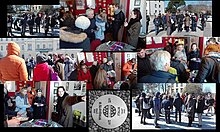 Nova Gorica railway station and the middle of the square | |
| Native name | |
|---|---|
| Namesake | Transalpina Railway [1] [2] Europe |
| Location | |
| Coordinates | 45°57′18″N13°38′05″E / 45.95500°N 13.63472°E |
![The station in early 20th century, when it was crossed by Gorizia Tramway [it]. Gorizia - Piazzale Transalpina.jpg](http://upload.wikimedia.org/wikipedia/commons/thumb/1/1b/Gorizia_-_Piazzale_Transalpina.jpg/250px-Gorizia_-_Piazzale_Transalpina.jpg)

Transalpina Square (Italian : Piazza della Transalpina, [3] meaning "Square of the Transalpina [Railway Line])"; Slovene : Trg Evrope, [4] meaning "Europe Square"), is a square divided between the towns of Gorizia, northeastern Italy, and Nova Gorica, southwestern Slovenia. The railway station of Nova Gorica is located at the eastern end of the square, on the Slovenian side.





